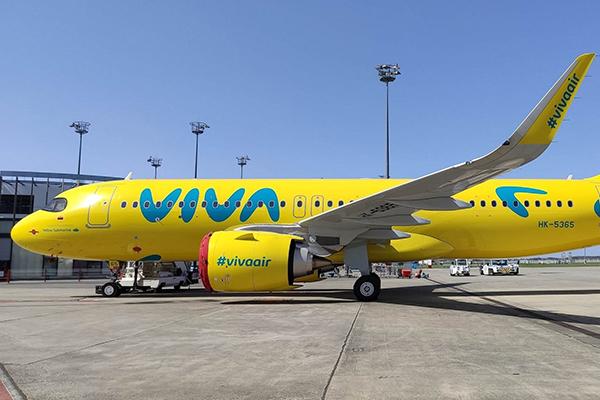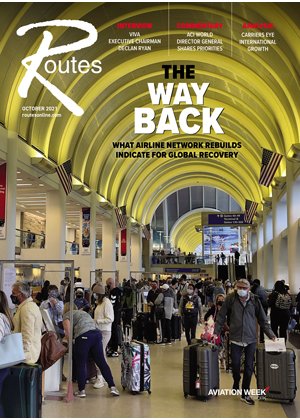
The industry has had a reset—how has this changed your thinking?
We’ve used COVID as an opportunity. Most people in Colombia, and it’s the same as Ryanair in Europe, realize that we’re on time and our aircraft are very new. When you’re traveling short-haul for two hours, new and clean airplanes on time is what people want. We’ve become the carrier domestically in Colombia for the beaches, which is great. And we’ve done very well and have significant market shares in the key markets like Cartagena, San Andres and so on.
The opportunity during COVID to renegotiate with lessors was really helpful. There were some nosebleed, power-by-the-hour deals in the marketplace for airplanes. We’ve got rid of a lot of our expensive aircraft, which, ironically, have been returned to GECAS and are now with Avianca. I don’t know what happened there but we’re very glad to see the back of them.
But how do you plan a network with so much uncertainty?
All carriers suffer from the differences in regulators. I’m very sympathetic for anybody in Europe because there’s 27 different opinions; that’s what the EU is. Ryanair has done an excellent job with regard to moving their airplanes around to where the market is. And that’s the benefit of being low cost and flexible.
It’s not as bad down here. The Colombian market is quite well established and the guys in the civil aviation authority by and large. Avianca has been around for a million years so sometimes we have to compete with that on the basis that they’re established and there would be a bit of favoritism with the government. We’re used to that stuff though, so it’s easier in this marketplace and we’ve launched new pilot international routes to Orlando, Mexico City and Cancun, and they’re doing really well. And that also helps with our utilization because some sectors in Colombia are quite short. Bogota-Medellin is one of the main routes and only 30 to 40 minutes. It takes a lot longer by road and that’s a huge advantage for us.

Routes Magazine
The domestic market is important for Avianca but when they get out of Chapter 11 their bread and butter will be international. We’re just going to focus on the key markets internationally, which primarily would be Florida, Texas, Mexico and places like that.
How about Brazil?
Brazil is interesting. It certainly needs more services out of Colombia, so doing that via our network is something we would seriously consider. I’m not too sure the market down there is really low cost with regard to domestic, but obviously it’s a huge market. If you look at Azul, who I would respect and are not low cost, they have to reinvent themselves every couple of years, going from turboprops to cargo, or whatever makes sense for Brazil. So that’s one of the factors.
LCCs rely heavily on demand stimulation. In the current climate how do you tackle this?
As with all low-cost carriers, our market research is going on the route for six months at $50 a fare. And if people don’t fly then you have your answer, so we will pull off and we have in the past. We had a big dustup a few years ago with an airport where the concession isn’t very efficient; we pulled out, and then we came back subsequently. We can do that kind of horse trading when we have to, but we don’t want to do it because it’s disruptive and sends out the wrong messages to our passengers.
The other thing you need to take into account is that Colombia is really big. It’s the largest middle class in the region on a percentage basis. That’s mainly people who have the $50 to go up to Cartagena, Santa Marta or some of the islands, so that’s our key market.
Is the lowest fee the most important factor when choosing airport partners?
The dynamics with airports are the same with all airlines worldwide. If somebody is being very competitive—like the Greeks at the moment, who I believe have welcomed Ryanair—that’s great. Medellin is quite dynamic and we’re actually hubbing and connecting passengers. Over 5% of our passengers are now connecting via Medellin so it’s becoming a bit of a hub. It’s kind of like the Fort Lauderdale of Colombia, on the basis that Bogota is Miami. It’s also 4 million people so it’s the size of Ireland’s population!
Is there scope for partnerships in the US and beyond?
Maybe. I thought the American and JetSMART deal was very interesting. I think what the big legacy guys are seeing in the US is that there’s so many ULCCs around the US market, you can’t avoid them now with regards to partnerships and connectivity. I think that was a real milestone. It will be interesting what else American does in the region because they had a relationship with LATAM and they fell out of bed on that one, so I think they’re hungry for more real estate throughout South America, including Colombia.
In the US there are new startups like Breeze and Avelo, along with smaller carriers. Would you consider working with one of those?
Yeah, of course. I’m not too sure about the modeling of Breeze, but we’re working away with Viva Aerobus, who are really dynamic and kind of the number two carrier now in Mexico. [Viva Aerobus CEO] Juan Carlos Zuazua is a rock star; he’s a great guy and he’s done a really good job there and the recent results are very good. I know that their intention is to IPO next year and I think it will be very successful.
We’d love to do something with Frontier or Allegiant. The guys in Allegiant are fantastic; [CEO] Maury Gallagher runs an amazing business there and if they want to come into our marketplace we would certainly look at partnering with them or perhaps adding more connectivity out of Las Vegas.
And how big are your growth ambitions?
We have to be a bit like a southpaw boxer. I think all low-cost airlines have to be clever with their punches, but we have another 30 airplanes coming, all [Airbus A320] neos. There are loads of opportunities for us in the marketplace here and we just have to make sure that we keep an eye on the big boys like LATAM, American and Spirit. Those are the ones who we wake up every morning thinking about.
Main photo credit: Aviation Capital Partners
Portrait credit: Carlos L. Rios
